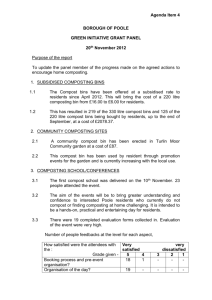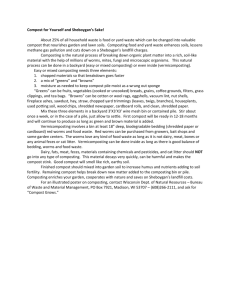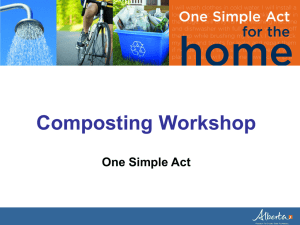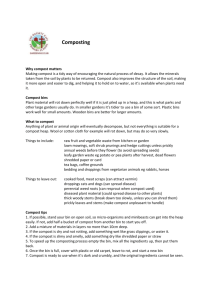From Garbage to Garden
advertisement
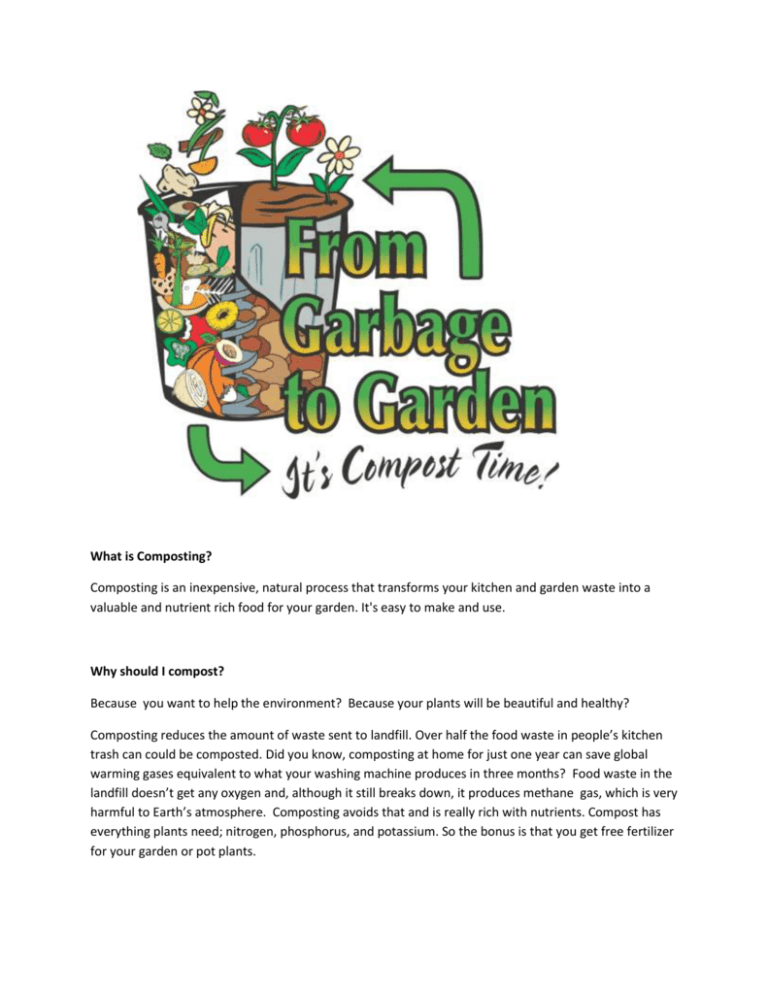
What is Composting? Composting is an inexpensive, natural process that transforms your kitchen and garden waste into a valuable and nutrient rich food for your garden. It's easy to make and use. Why should I compost? Because you want to help the environment? Because your plants will be beautiful and healthy? Composting reduces the amount of waste sent to landfill. Over half the food waste in people’s kitchen trash can could be composted. Did you know, composting at home for just one year can save global warming gases equivalent to what your washing machine produces in three months? Food waste in the landfill doesn’t get any oxygen and, although it still breaks down, it produces methane gas, which is very harmful to Earth’s atmosphere. Composting avoids that and is really rich with nutrients. Compost has everything plants need; nitrogen, phosphorus, and potassium. So the bonus is that you get free fertilizer for your garden or pot plants. How do I start my own compost pile? You can start your compost pile anytime. Most people start in the Fall so that they can use the dead leaves in their yard. Some people start in the Spring when they begin to mow their lawns and produce grass clippings. Time of year really doesn’t matter. Pick a somewhat sunny spot in your yard. You should use the ground rather than a concrete patio or wooden deck. You can buy a compost bin or make your own. There are many types of compost bins available. Some are tumblers, others are plastic bins, and others are simple wire cages that look dog kennels. They come in different sizes and at very different prices. Buy what fits your needs and your budget or make your own. An old plastic trashcan may be used as a compost bin. If used upside down with the bottom cut out, leave an edge of an inch or so to provide some stability. The lid can be placed over the bin to keep the rain out and heat in. If the bin is used the right way up with the bottom remaining intact, drainage holes will need to be made in the base of the bin to allow liquid to drain out. Used this way it will also need to be completely emptied to get at the mature compost at the bottom, whereas used upside down it will be relatively simple to lift the bin off to get at the mature compost. Wooden composters are open air "pens" for compost. Old pallets are often used to simply make an aerated box. This is cheap, easy and a simple method of composting. You may also create your own bin with wire mesh and large stakes in the ground. These types of bins can accommodate more compost. They also mature a bit more slowly because they are not closed from the elements and temperature. Once you have placed your bin outside in a good spot, it is time to collect some material to compost. Keep a medium sized tub in your kitchen. You can put vegetables, fruit, teabags, paper towel tubes, eggshells, etc. into your tub. You should not put in meat or fish, dairy products or cooked foods. Outside, keep your garden waste in a small trash can or bin. Dump weeds, grass clippings, etc. there. Do not put in dog poop or cat litter! Also, don’t add diseased plants or perennial weeds or weeds with seedheads. Dump your kitchen waste along with your garden waste into your compost bin. A good mix is about a 50/50 mix of” greens” and “browns.”” Greens” rot quickly and provide nitrogen and moisture. They include; raw vegetable scraps and peels, tea bags, coffee grounds and filter papers, old fruit scraps, spent plants from your garden, grass clippings, etc. “ Brown”s are slower to rot, provide carbon, and allow for air pockets. They include; small twigs, bark, cardboard, leaves, sawdust, scrunched up papers, etc. Keep adding this equal mix and wait. When you check your compost, if it seems too wet, add more browns. If it seems sort of dry, add more greens or mist it with water. It should be moist and the center should be warm. Turn it with your rake or shovel occasionally. Just flip it over a bit to sort of stir the pile up and keep oxygen in it. (Your compost pile will be really warm in the center of the pile where the debris is breaking down, even on the coldest of days.) Oxygen keeps the aerobic bacteria alive and working. It takes about nine to twelve months for nature to produce your compost. When the compost looks like moist dirt and smells like fresh earth, it’s ready. It might look a little lumpy and have some twigs or eggshell in it. That’s okay. Scoop it up and use it on your yard or in your beds or even in your pot plants. It’s nature’s fertilizer!

